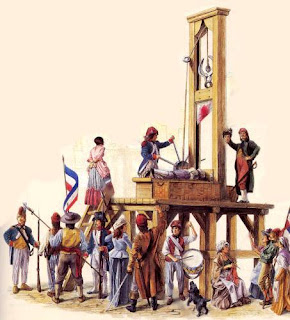Day of Daggers
The nobles - many of them army officers - had gained entrance to the palace by displaying cartes d'admission (passes) and were carrying poignards (daggers or short swords), concealed beneath their waistcoats or tucked into their boots.
When a group of the officers were discovered in the King's private apartments, an alarm was raised. Soon, hundreds of Revolutionaries stormed the palace and surrounded the King's loyal nobles.
When questioned, they claimed they only wished to "protect the King."
Some feared the "Poignards" had visited the palace to help spirit the King and Queen away using a secret, subterranean corridor which linked the palace to the prison Vincennes.
The Marquis de La Fayette, who had been quelling an uprising in the faubourg Saint Antoine, soon arrived with his garrison of National Guardsmen.
La Fayette ordered the men to put down their weapons and disband.
The nobles refused.
In a hope to prevent bloodshed, La Fayette suggested the King order the men to comply.
Though it surely must have pained him, Louis XVI ordered his faithful followers to set down their weapons.
They obliged...and were immediately arrest. Some of the Poignards lost their lives, but most were forced to emigrate, leaving behind their homes and their belongings.
After reading this, how do you feel about La Fayette? Do you think he acted wisely when faced with a difficult position? Or, do you think he betrayed the very class of men into which he was born?
Did you know...
...Poignard means dagger in French?
...In medieval times, the Château de Vincennes was a massive castle which stood in the small town of Vincennes, just east of Paris? In the 18th Century, it was used as a porcelain factory and a prison.
...La Fayette was of noble birth but initially believed in many of the ideals of the Revolution?
...Many of the men La Fayette associated with before and during the Revolution ended up losing their lives on the scaffold, yet he lived to old age and died of pneumonia? He is buried in the Picpus Cemetery in Paris.
...A few months after the Day of Daggers, the Royal Family would attempt an escape? This failed, fateful event would be called the Flight to Varennes.
...In 1871, the Tuileries Palace caught on fire? Its blackened stone shell was finally demolished in 1883. Today, visitors can stroll through the gardens.
 |
| Mob marches on the Tuileries |
 |
| Day of Daggers ~ Tuileries Palace |
 |
| The Nobles laying down their arms |
 |
| Fan commemorating the Day of Daggers |





Interesting story that most people wouldn't know about, thanks for sharing! I do believe that La Fayette's goal was to avoid more bloodshed, and even though the Poignards had to emigrate and leave everything behind, they probably would have lost their lives had there been a battle inside the Tuileries that day...
ReplyDeleteI always considered Lafayette to be a hero. After reading this I do not think that. Thank you for this blog post. You're brilliant.
ReplyDelete